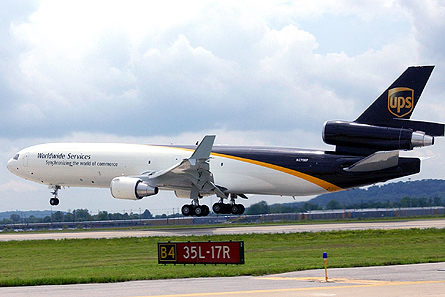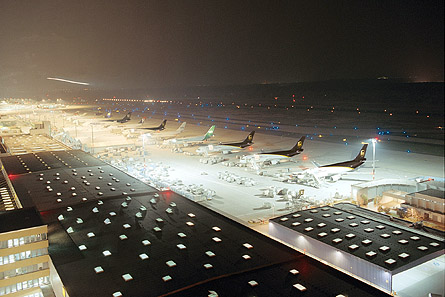Most people have probably never taken the time to consider how the packages they send by an express courier arrive safely at their destination. Like many things these days, the capability and the process are taken for granted: you call a courier; he collects the package, some magic happens and the package is delivered safely the next day.
But the magic is actually quite a complex process involving the latest technology and some very expensive equipment - not least of which could be a $60 million widebody freighter aircraft.

During the event to mark the official opening of UPS's $135 million expansion of its European air hub at Cologne/Bonn airport (CGN) on 30 January, I spent part of the night at the facility to witness how it all works at first hand. The hub’s new wing has pushed its hourly package-handling capability to 110,000 - that's more than 30 packages a second - and there is provision to grow this to 165,000 per hour. As well as handling 31 aircraft freighters between 23:00 and 05:00 each night, CGN also processes the contents of 150 trucks that feed from the nearby industrial centres along the Rhine river and connect to UPS's ground hub 180km (110 miles) south at Fechenheim, near Frankfurt.
UPS's first movement at CGN occurs at around 21:00 when the daily Boeing 767-300F flight departs for the company’s US hub in Louisville, Kentucky. Its arrival coincides with the evening sort there. This ensures that packages from Europe are fed into the US network and will reach their destination by the following morning.
However, it is at 23:00 when the CGN hub really starts to gear up. This is when the flights begin arriving from UPS’s outstations within its European network, as well as from the USA and Asia. As with UPS’s operations worldwide, the company’s European operations are flown by aircraft operated by its UPS Airlines division supplemented by a large fleet of chartered freighters.
Of the 31 aircraft serving CGN nightly, 16 are operated by the in-house airline - four Airbus A300-600Fs, four 757-200Fs, six 767-300Fs and two MD-11Fs. The A300s and 757s operate intra-European routes while the 767-300Fs and MD-11Fs fly transatlantic (to Louisville, New York Newark and Philadelphia – some via stops at other European cities) to UPS’s hubs in Taipei and Manila. There are also direct flights to Dubai and Hong Kong.
The charted fleet comprises two A300B4Fs (one leased from Channel Express and one from MNG Cargo), one 737-300F operated by Bluebird Cargo, six 767-200Fs operated by Maersk-owned Star Air of Denmark, as well as six turboprop freighters - three ATRs and three Fokker F27s.
“The strategy has been to upsize aircraft capacity to cope with growth – we have fewer movements each night into Cologne/Bonn now than in 2001,” says UPS Europe’s Uwe Detering. This has for example seen the smaller, noisier 727-100 Quiet Freighters replaced by 757s, while some 757 routes have been upgraded to A300Fs.
 |
All photos ©UPS |
Once each container is ready, it is positioned manually to the edge of the freight hall using roller mats, where it is then transferred to the waiting aircraft. By 03:00 the first aircraft is ready to leave, and one by one the hub empties with the last departure around 05:00. A calm then descends across the hub, and with a bit of luck that important package is close to arriving safely at its destination.
MAX KINGSLEY-JONES / COLOGNE
Source: Flight International




















